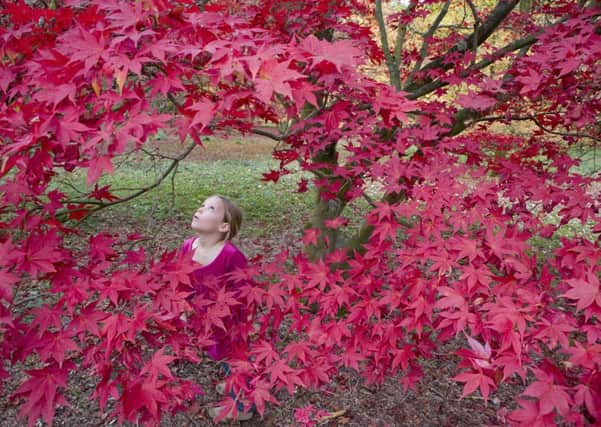Autumn colour a tonic to beating the winter blues


The conservation charity released the findings as part of its Great British Walk 2014, which launched this month with an invitation to enjoy a rainbow of walks. Shades of blue you find on walks by water or when the landscape is coloured by the evening’s darkening sky were found to help soothe away stress (36%), while the greens of hilltops and pine woodlands leave people feeling more connected with the natural world (52%).
Renowned colour psychologist, Angela Wright, was commissioned to produce a report alongside the findings assessing the importance of autumnal colours experienced in different environmental landscapes.
Advertisement
Hide AdAdvertisement
Hide AdAngela said: “Natural colour schemes can inspire us and lift our spirits. Autumn, combined with the rich light at this time of the year, is a flamboyant blaze of intense colours with each affecting us in a different way.
“People are more susceptible to the effects of aesthetic influences in the natural world than to any other colour sources.
“Fresh air, exercise and the sense of getting away from it all play a positive role in improving our well-being. However, it’s the colours that we experience which are the most powerful tonic to affecting our mood.”
Despite more than 70% of people finding that autumn walks help to combat winter blues, almost half (48%) admit to not going on enough walks during the autumn months with almost a third (32%) claiming it’s because they rarely get the chance to go on a stroll.
Advertisement
Hide AdAdvertisement
Hide AdNational Trust ranger for Nymans, Chloe Bradbrooke, said: “Autumn bursts with colour and life. It’s the best time to see nature and wildlife at its most spectacular, but it’s also a time of change and reflection.
“This season is the perfect time of year for walking. The trees and landscape start to turn every shade imaginable which lifts your spirits; it’s cooler, but not cold, and you could get a misty morning with those familiar damp smells or a clear, crisp day when everything appears to shine brighter. The National Trust looks after some beautiful gardens and landscapes, and our role as a conservation charity is to maintain these fantastic places.”
To help encourage more people to make the most of the autumn palette the National Trust in Sussex has unveiled its top walks inspired by the colours of autumn. Chosen by Trust rangers, they showcase the rainbow of colours and scenery that can be enjoyed in the county:
Nymans
The ancient woods on the Nymans estate are filled with glorious autumnal sights. Take the self-guided trail down medieval tracks to mysterious yellow Mesolithic sandstones, where you’ll also see vibrant green mosses on tree trunks and shady banks. The tracks and trees are home to colourful fungi such as red-spotted fly agaric and luminous orange chicken-of-the-woods. As you reach Conifer Avenue look out for the magnificent American redwoods, whose bark turns a deep orange in the low autumn sunlight, whilst in Cow Wood you’ll find emerald-green ferns.
Advertisement
Hide AdAdvertisement
Hide AdYou can join a guided woodland walk every Thursday at 11.30am, no booking required (11 September to 23 October). Capture Nymans’ glorious autumn colour on one of its garden photography courses (17, 22 & 31 October, £15, book on 01444 405250), or art workshops (23, 24 & 25 October, £60, book on 01444 405250)
The National Trust is encouraging the nation to join in and enjoy the autumn colours by getting out and sharing their vibrant walking photos on Twitter, Instagram and Facebook using the hashtag #GBwalk.
Petworth House and Park
For hints of autumn gold, follow the downloadable Ancient Tree Trail at Petworth House and Park, and discover the views that inspired England’s greatest landscape artist, JMW Turner. The magnificent oaks, limes, beeches and chestnuts create canopies of butter-coloured foliage, and in early autumn, the parkland is transformed into a savannah-type landscape – a golden expanse of tall waving grasses. Look out for the flaming yellow and orange foliage of acers, as well as vibrant red oaks.
There are guided walks in Petworth Park throughout September and October, which may include the exciting fallow deer rut; deer have been at Petworth for centuries and are captured in Turner’s painting Sunset, Fighting Bucks, which can be seen in the Carved Room. Visit www.nationaltust.org.uk/petworth-house or call 01798 342207 for more information.
Advertisement
Hide AdAdvertisement
Hide AdEnjoy a film preview of Petworth Park’s Ancient Tree Trail, with walking enthusiast, Jo Dyson: http://youtu.be/aQQqq3LBVI0.
Woolbeding Countryside
The ancient, lichen-covered Woolbeding Bridge is the start and finish point of a two mile self-guided circular walk that follows the picturesque River Rother. The walk, which includes glorious vistas of the South Downs, takes in ancient woodland in shades of russet, orange and gold in autumn, and the picturesque Stedham Mill.
On 18 October, take part in a 12 mile leisurely walk from Black Down to Woolbeding Common and a minibus ride back. Enjoy views over open heaths before descending into ancient woodland full of fungi, wildlife and rich autumn foliage. 10.30am-4pm, £3, book on 01730 816638, meet at Black Down car park.
Slindon Estate
A glorious mix of downland and farmland, woodland and wildlife-rich hedgerows greets walkers on the Slindon Estate. Choose from three downloadable walks, one of which takes in spectacular views of the coast, the Isle of Wight, even the spire of Chichester Cathedral. Stroll along 2,000 years of grassy Roman road, and up to 19th-century Nore Hill Folly where you can gaze across to the famous beech trees of Slindon – a canopy of gold and bronze foliage. A well-sited bench allows walkers to enjoy the panorama.
To find out more and download the National Trust’s walks, visit www.nationaltrust.org.uk/gbwalk
Report and picture contributed by the National Trust.